NVIDIA GeForce GTX 760 Review: The New Enthusiast Kepler
by Ryan Smith on June 25, 2013 9:00 AM ESTPower, Temperature, & Noise
As always, last but not least is our look at power, temperature, and noise. Next to price and performance of course, these are some of the most important aspects of a GPU, due in large part to the impact of noise. All things considered, a loud card is undesirable unless there’s a sufficiently good reason – or sufficiently good performance – to ignore the noise.
With both the 600 series GK104 parts and the GK104 based GTX 770 as a backdrop here, we’re not expecting any great surprises here. Power consumption is going to approach the GTX 670 thanks to GPU Boost 2.0 and the identical TDPs. And since the cooler is also the same, acoustics should also be similar. Only idle power should show any real variation.
| GeForce GTX 760 Voltages | ||||
| GTX 770 Max Boost | GTX 760 Max Boost | GTX 770 Idle | ||
| 1.2v | 1.2v | 0.850v | ||
Like the GTX 770, GTX 760 is spec’d to a stock top voltage of 1.2v. This buys NVIDIA the 1100MHz+ clockspeeds we’re seeing, but it drives up power consumption.
| GeForce GTX 760 Average Clockspeeds | |||
| Max Boost Clock | 1149MHz | ||
| DiRT:S |
1134MHz
|
||
| Shogun 2 |
1127MHz
|
||
| Hitman |
1149MHz
|
||
| Sleeping Dogs |
1139MHz
|
||
| Crysis |
1145MHz
|
||
| Far Cry 3 |
1132MHz
|
||
| Battlefield 3 |
1123MHz
|
||
| Civilization V |
1139MHz
|
||
| Bioshock Infinite |
1131MHz
|
||
| Crysis 3 |
1105MHz
|
||
Looking at the average clockspeeds among our games, despite the official 1033MHz boost clock for GTX 760 always boosts to an average over 1100MHz, with most games boosting to around 1130MHz. The limiting factor here is typically temperatures, which quickly hit 80C at the highest boost bin and its 1.2v operating voltage. A card with a better cooler would likely have no trouble sustaining 1149MHz here.
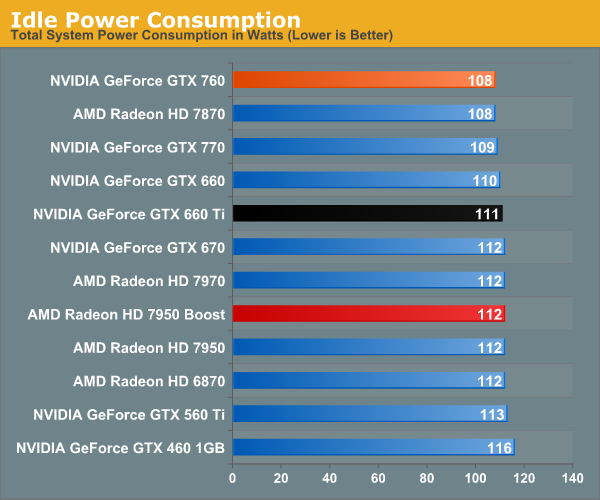
As we saw with the GTX 770 a few weeks ago, NVIDIA’s idle power consumption as measured at the wall has come down a couple of watts compared to the older GK104 cards. With a lower idle clockspeed compared to the GTX 660 Ti and its ilk, NVIDIA has been able to shave off that wattage without any more substaintial changes. However I continue to be surprised that we’re seeing any difference between the GTX 760 and the 7950B, as AMD is no slouch here either.
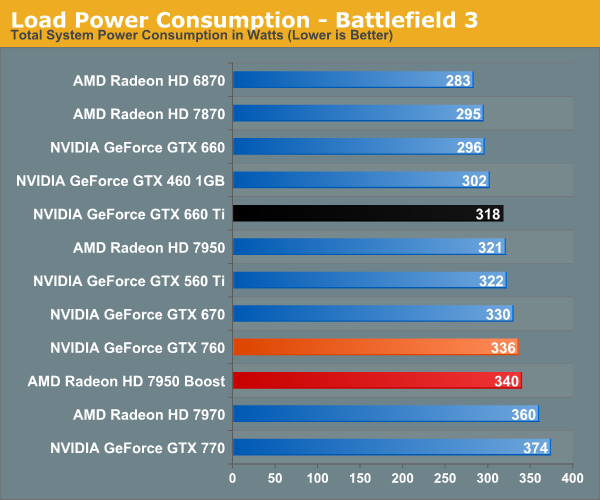
Moving on to load power under Battlefield 3, our results validate our earlier theories on power consumption based on the spec sheets. Wall power with a GTX 760 is 6W higher than GTX 670 in this test, and 18W higher than with a GTX 660 Ti. There’s no getting around the fact that GTX 670-like performance requires GTX 670-like power consumption.
At the same time the power consumption of the GTX 760 is almost identical to the 7950B at the wall. Though given the 7950B’s lower performance in this benchmark, what we’re actually seeing is lower CPU power consumption offsetting the 7950B’s higher power consumption.
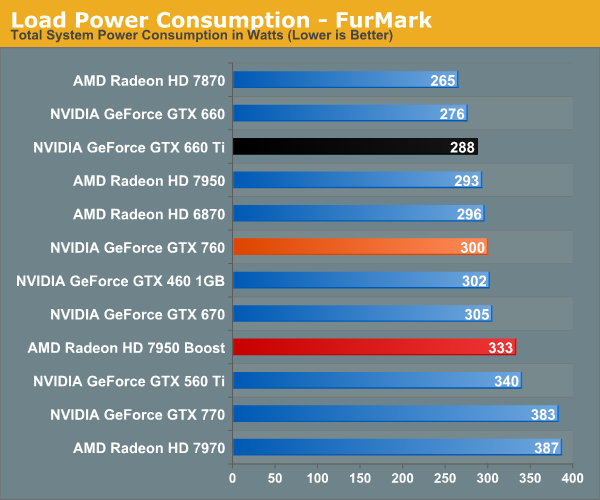
With Furmark the story is fairly similar for the NVIDIA cards, all of which come close together due to their similar TDPs. Meanwhile the 7950B pulls about 30W more at the wall, in-line with its 200W TDP. NVIDIA edged out AMD on power efficiency with the 600 series, and we’re going to see the same thing on the 700 series.
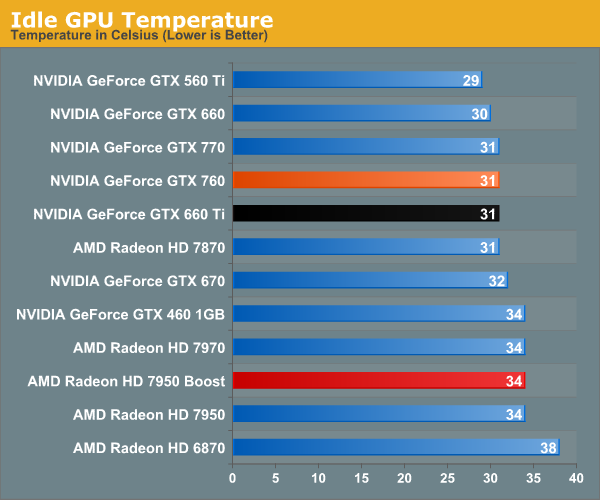
Based on the same cooler and GPU as the GTX 670, the GTX 760 offers no grand revelations here. 31C is standard for this type of blower cooler.
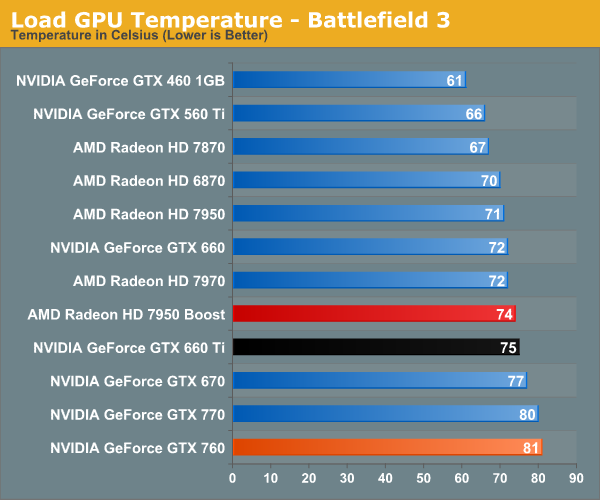
Even though the GTX 760 and GTX 670 have identical TDPs, the presence of GPU Boost 2.0 means that the GTX 760 operates nearer its TDP more often, and in this case the 80C throttle imposed by GPU Boost makes itself felt. 81C does end up being the worst among the cards in this collection, but it’s a reasonable temperature for a GK104 GPU, to the point where in temperature limited scenarios this is exactly where it’s designed to top out at.

With FurMark our results are much the same as with BF3. The slower response time of the fans on the GTX 770 and GTX 760 mean that both cards top out at 82C before temperatures level out, a few degrees warmer than with the GTX 670 and GTX 660 Ti. Alternatively the 7950B and its more powerful fan keep temperatures at or below 75C for any workload we throw at it.
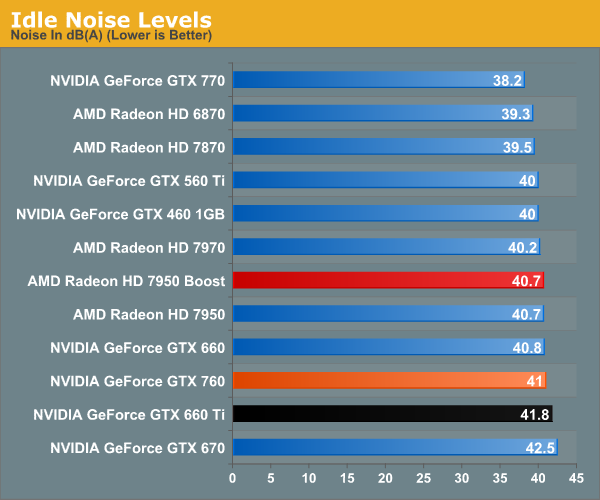
Since NVIDIA used the same cooler/fan assembly as on the GTX 670, the GTX 760 is going to give us similar acoustics. Unfortunately that includes the characteristic faint grinding noise that we’re previously mentioned. Idle noises as a result are respectable, but GTX 770 this is not.

Moving to fan noise under load, here we can see NVIDIA’s default fan curve and 80C throttle once again pay off. The GTX 760 hits 50dB under BF3, which for this specific cooler is actually doing a bit better than average, as evidenced by the slight advantage the GTX 760 has over the GTX 670. The GTX 770 and Fermi cards are something of spoilers here though, a reminder of what the Titan cooler and open air cooling can do. We will have some custom GTX 760s next week, so it will be interesting to see how much better these cards are when it comes to noise. 50dB is by no means bad, especially for the performance, but at this point we’ve seen lower noise levels out of cards with similar price tags and TDPs.
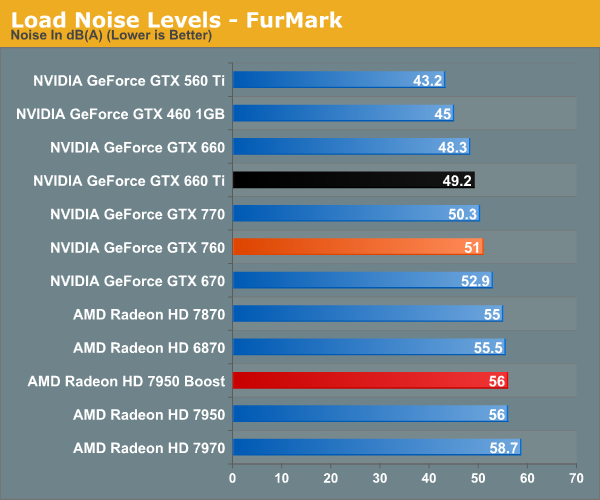
Finally, FurMark once again paints a picture very similar to what we saw with Battlefield 3. For NVIDIA cards this is middle of the road, while at 5dB quieter than the reference 7950B it’s a significant improvement.










110 Comments
View All Comments
Nfarce - Tuesday, June 25, 2013 - link
Last year I was debating going 570 SLI and buying a second one, or selling it and going for a single 680. I went with the latter and am glad. I spent a lot of research on the decision, and 570 SLI is slightly lower than a single 680, within 90-95% depending on game. So if the 770 beats the 680 by a solid 5-10% (again, depending on games), it's going to really beat 570 SLI.Kutark - Wednesday, June 26, 2013 - link
Yeah. Im thinking i might stick with a single card. Maybe i should hold off and wait for the 760 Ti that will inevitably come. Really the GTX570 is a great card, its just getting a little long in the tooth, and frankly im kind of spoiled, I always want to make sure any game i can play runs at max settings as far as shadows/textures, etc. I'm apparently the only person on the planet who hates AA (makes things fuzzy), so i typically play most games at 1920x1080 with all settings maxed, 0xAA and 8xAnisotropic. The 570 is doing fine in that respect on everything i play now, i'm just worried about some of the upcoming games like BF4, Witcher 3, etc.I usually prefer to stay with single cards, i've just seen way too many situations where SLI didnt work (i.e. game didnt support it), produced poor results, etc. Not to mention the heat, and power consumption issues.
Regardless, thanks guys for your responses, really helped me clarify the issue.
Off Topic, im currently running an i7-2600k @ 4.1ghz stable, do you think im fine as far as CPU goes for these future games? Haswell doesn't seem to be a huge jump over Gen3 i7.
mapesdhs - Wednesday, June 26, 2013 - link
Kutark writes:
> Yeah. Im thinking i might stick with a single card. ...
Nfarce is spot on about 570 SLI, though 580 SLI can definitely beat a 680
(1.5GB 580s are quite cheap on eBay these days, eg. I've seen them go for
as little as 190 UKP total for two). Assuming you're familiar with the
difference between a 570 and 580 performance-wise, then with respect to
Firestrike Extreme, see the lower graph on this page:
http://www.legitreviews.com/article/2201/9/
and compare to the following 580 SLI results I obtained (check the
Graphics scores; the overall scores are skewed against me a bit as my
system is just a quad-core, though in this case I end up with better
overall scores anyway vs. a 680, even with the 580s @ stock):
Stock: http://www.3dmark.com/fs/588100
Oc'd: http://www.3dmark.com/fs/518352
For reference, here's just one 580 at stock, showing that it's Graphics
score matches the article's 580 quite nicely:
http://www.3dmark.com/fs/588046
Also, my oc'd 580 SLI Graphics score matches a 780. :D (4506 vs. 4483)
However, as many would rightly point out, the 780 has a huge VRAM advantage
which is ideal for games like heavily modded Skyrim (though of course there
are 3GB 580s, but they tend to cost more - mine was 170 UKP total whereas
1.5GB 580s normally go for around 100 to 125 UKP), and further differences
mean a 780 would likely be quicker in other cases, especially if you wanted
to run a multi-screen setups with AA, etc.
I haven't bothered running normal Firestrike until now, so here are stock
and oc'd runs for comparing to the upper graph on the legit page:
Stock: http://www.3dmark.com/fs/588907
Oc'd: http://www.3dmark.com/fs/588883
At stock, 580 SLI easily beats a 680. Oc'd, the Graphics score is well
ahead of a 780 (infact it's higher than the Titan). This suggests, as one
might expect, that as the visual load becomes more complicated, a single
better card like a 780 will shows its strengths, ie. SLI'd 570/580s are
good at typical HD res, but at resolutions like 2560x1440 a newer card
would be more sensible.
There's also the issue of power consumption if you added a 2nd 570; in
the long term, would the additional electricity cost end up being not that
much less than the cost difference compared to just upgrading to a single
newer card? Hard to answer this as elec prices vary wildly by location.
There's also the extra heat, and as you say the issue of which games run
well in SLI since not all do.
Btw, here's an oddity: changing the SLI rendering mode can have a
dramatic effect on Firestrike Extreme scores, eg. while still at stock
speed, here are my two 580s using Alternate Frame Rendering 1 (AFR1),
compared to the earlier link which uses NVIDIA Recommended (examine the
individual test results):
http://www.3dmark.com/compare/fs/588100/fs/588603
Graphics Test 1 doesn't change, but Graphics Test 2 increases by some
36%, hence the Graphics score shoots up 20% from 3625 to 4363. On the
other hand, the Combined Test drops by about 10%. I notice this test uses
a lot of VRAM, so perhaps AFR1 doesn't handle heavy VRAM loading so well.
I checked by running normal Firestrike with the two different SLI modes,
the result was identical, suggesting that AFR1 may be better if a game is
taxing VRAM resources a lot, ie. it may be worth manually experimenting
with one's games to see if a different SLI mode gives higher performance.
I tested with 3 cards aswell; the variation in results depending on SLI
mode is even more pronounced (not checked with 4 cards yet, need to move
them into the 3930K case). For the sake of completeness, here's the link
(done with rather low 825 core clocks as the M4E mbd used has no spare
slots to permit decent oc'ing with 3 cards):
http://www.3dmark.com/fs/518524
> ... Maybe i should hold
> off and wait for the 760 Ti that will inevitably come. ...
I read a piece yesterday which suggested NVIDIA wasn't going to release
any more cards this year, but who knows, that could easily change. It
would certainly be unusual if they didn't come out with a 760 Ti at some
point, or something equivalent.
> im kind of spoiled, I always want to make sure any game i can play runs
> at max settings as far as shadows/textures, etc. ...
:D:D Me too.
> ... I'm apparently the only
> person on the planet who hates AA (makes things fuzzy), ...
That can certainly happen with some games. Best to experiment with the
various options. Back when I was playing Oblivion on a 22" CRT at
2048x1536, I indeed found it better to leave AA off (because the dot
pitch was so small, no AA at the high res looked quite good). However,
with the games I'm playing now (FC2, Crysis2), turning on AA does look
better, but yes some modes are better than others.
> ... The 570 is doing fine in that respect on everything i play now, i'm
> just worried about some of the upcoming games like BF4, Witcher 3, etc.
If you don't plan on upgrading your display to a higher res, then adding
a 2nd 570 would work quite well performance-wise, but on the other hand...
> situations where SLI didnt work (i.e. game didnt support it), produced
> poor results, etc. Not to mention the heat, and power consumption issues.
... those are all very valid points to consider. Mind you, your CPU is
running at quite a low clock, so extra heat shouldn't affect your CPU config,
unless you have a very simple cooler.
> Off Topic, im currently running an i7-2600k @ 4.1ghz stable, do you think
> im fine as far as CPU
A 2600K will easily run at 4.5 to 4.8 depending on the chip, and many will
run at 5.0+, so you have plenty of scope for boosting your CPU performance
should you feel that necessary. The limitation on how high it can go is more
likely to be determined by your PSU, mbd, RAM, CPU cooler config and of course
just general luck of the draw re the particular 2600K you have.
Ian.
Artas1984 - Sunday, August 16, 2015 - link
You have done your research very wrong.I had GTX570 and GTX670 in the past. The performance gap was a consecutive 33 % in favor of GTX670 in 20 different games. Documented that in the forums.
Meaning GTX680 is 50 % faster than GTX570.
So SLI GTX570, if scaling is from 50 to 100 %, should be always ahead of GTX680.
skgiven - Sunday, August 4, 2013 - link
Comparing against last years reference GTX660Ti (915MHz) has little merit - most (>90%) of 660Ti's are non-reference and boosting to 1200MHz is fairly standard (22% more than 980MHz)! The most recent 660Ti's are even sweeter on the power.Including a recent FOC 660Ti and some lesser cards in SLi (GTX 650 ti Boost, which wins hands down and 460) would have made for a very nice review.
The 760 wins in high bandwidth games, but not low memory dependent games and apps, and not in terms of Performance/Watt.
BTW. I'm not seeing the price comparison, even now the GTX660Ti is still much less expensive.
AlucardX - Tuesday, June 25, 2013 - link
doesn't look like much of an improvement compared to my overclocked 7850 that i bought for $250 over a year ago..Parablooper - Wednesday, June 26, 2013 - link
Wow. On 1080p Battlefield it beats a 7970... $270 price point vs. $400.... I like AMD but they better make a move soon or they're off the market.king-dubs - Wednesday, June 26, 2013 - link
It doesn't. Anandtech is still using 7950/7970/7970GHz results from pre-12.11 drivers.http://tpucdn.com/reviews/NVIDIA/GeForce_GTX_760/i...
Also the 7970 dropped briefly to ~$300 two days ago, and the 7950 (Sapphire Dual-X) is still at $259 after MIR @ Newegg.
king-dubs - Wednesday, June 26, 2013 - link
Guru3D results are consistent with TPU:http://www.guru3d.com/index.php?ct=articles&ac...
Ryan Smith - Wednesday, June 26, 2013 - link
The 7970 results are with Catalyst 13.5 B2 (freshly composed for the GTX 780/770 reviews).The 7950 results are with Catalyst 13.6 B2 (freshly composed for this article)